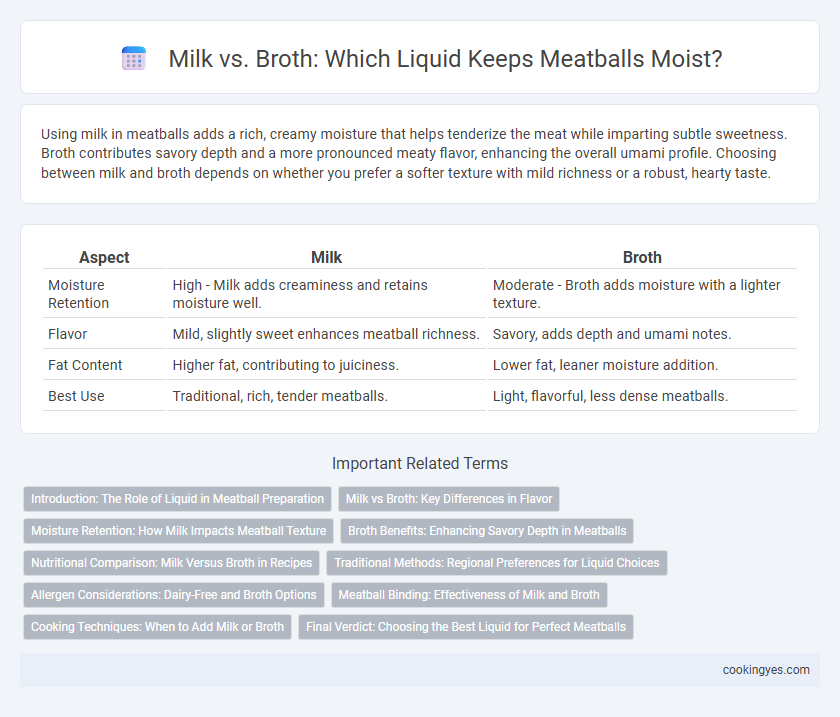Using milk in meatballs adds a rich, creamy moisture that helps tenderize the meat while imparting subtle sweetness. Broth contributes savory depth and a more pronounced meaty flavor, enhancing the overall umami profile. Choosing between milk and broth depends on whether you prefer a softer texture with mild richness or a robust, hearty taste.
Table of Comparison
| Aspect | Milk | Broth |
|---|---|---|
| Moisture Retention | High - Milk adds creaminess and retains moisture well. | Moderate - Broth adds moisture with a lighter texture. |
| Flavor | Mild, slightly sweet enhances meatball richness. | Savory, adds depth and umami notes. |
| Fat Content | Higher fat, contributing to juiciness. | Lower fat, leaner moisture addition. |
| Best Use | Traditional, rich, tender meatballs. | Light, flavorful, less dense meatballs. |
Introduction: The Role of Liquid in Meatball Preparation
Milk and broth serve distinct roles in maintaining meatball moisture and texture. Milk imparts a creamy richness and tender crumb by loosening the meat proteins, while broth enhances savory depth and juiciness through its flavorful liquids. Choosing between milk and broth depends on the desired flavor profile and moisture retention in the final meatball dish.
Milk vs Broth: Key Differences in Flavor
Milk adds a creamy richness and subtle sweetness to meatballs, enhancing tenderness and providing a smooth texture. Broth contributes a savory depth with a more complex, umami flavor that intensifies the overall taste profile. Choosing milk or broth directly affects the moisture level and flavor nuances, making milk ideal for mild, creamy dishes and broth best for robust, hearty meals.
Moisture Retention: How Milk Impacts Meatball Texture
Milk enhances meatball texture by improving moisture retention through its proteins and fats, which create a tender and juicy interior. The casein proteins in milk bind water more effectively than broth, preventing dryness during cooking. Unlike broth, milk's fat content contributes to a richer mouthfeel and consistent moisture distribution inside meatballs.
Broth Benefits: Enhancing Savory Depth in Meatballs
Using broth instead of milk to moisten meatballs significantly enhances their savory depth by infusing rich umami flavors from beef, chicken, or vegetable broth varieties. Broth's natural collagen and gelatin content improve meatball texture, creating a juicier and more tender bite while complementing herbs and spices. This method also aligns with savory cooking techniques, elevating the overall complexity and mouthfeel beyond the neutral creaminess of milk.
Nutritional Comparison: Milk Versus Broth in Recipes
Milk enhances meatball moisture by adding creamy texture and contributes calcium, vitamin D, and protein, supporting bone health and muscle repair. Broth offers lower calories and sodium, with collagen and minerals that aid joint health and hydration. Choosing milk boosts nutritional density, while broth maintains lightness and electrolyte balance.
Traditional Methods: Regional Preferences for Liquid Choices
Traditional methods of meatball preparation often vary regionally in their choice of liquid to enhance moisture, with milk favored in many Italian recipes for its creamy texture and subtle sweetness. Broth, commonly used in Scandinavian and Eastern European meatballs, imparts a savory depth and helps maintain a tender consistency during cooking. These liquid choices significantly influence the flavor profile and mouthfeel, reflecting cultural preferences in classic meatball dishes.
Allergen Considerations: Dairy-Free and Broth Options
Using broth instead of milk for meatball moisture caters to dairy-free diets and reduces allergen exposure, making it ideal for individuals with lactose intolerance or milk allergies. Broth options, such as vegetable, chicken, or beef broth, provide rich flavors without the allergenic proteins found in dairy. Selecting broth enhances meatball texture while ensuring an inclusive recipe suitable for diverse dietary needs.
Meatball Binding: Effectiveness of Milk and Broth
Milk enhances meatball binding by contributing proteins and fats that create a tender, cohesive texture, while broth provides moisture with less fat, resulting in a lighter binding effect. The casein proteins in milk improve emulsification, helping meatballs hold their shape better during cooking, whereas broth's lower fat content may require additional binders to maintain structural integrity. Using milk typically yields juicier, more tightly bound meatballs, whereas broth offers a subtler moisture profile suited for leaner blends.
Cooking Techniques: When to Add Milk or Broth
Adding milk to meatballs during mixing creates a tender, moist texture by softening the meat proteins before cooking. Broth, on the other hand, is best introduced during cooking or simmering to infuse additional flavor and maintain moisture without diluting the meatball's firmness. For optimal moisture, incorporate milk in the raw mixture and use broth in the sauce or cooking liquid when simmering meatballs.
Final Verdict: Choosing the Best Liquid for Perfect Meatballs
Milk enhances meatball moisture by tenderizing proteins and adding subtle richness, resulting in a creamier texture. Broth imparts a savory depth and natural umami, boosting flavor without extra fat. For perfectly moist meatballs, milk is ideal for softness and richness, while broth excels when a robust, flavorful profile is desired.
Milk vs Broth for meatball moisture Infographic

 cookingyes.com
cookingyes.com